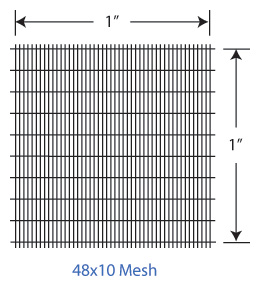

January 23 2018

In a previous article we discussed the RDW weave patterns and how the screen will behave differently depending on the weave pattern design. This is an important factor to assure consistent flow of the melt polymer through the continuous belt screen changer. However, it’s not the only factor. The mesh size also plays a crucial role in assuring consistency of the melt.
Mesh size is simply the number of openings in one linear inch, for example a 48 x 10 mesh will have 48 openings per inch in the horizontal direction and 10 openings per inch in the vertical direction. As mesh size increases the size of the openings will decrease, and thus the size of particles retained. It is very important to remember mesh size is not a precise measurement of particle retention size. This is because screens can be made with different materials and different thickness of wire. This variable allows two filters of the same mesh size to have completely different particle retention sizes. While it is standard practice to order screen based on mesh sizes it is best to verify the particle retention size normally measured in microns of the screen to ensure it meets your filtration requirements. There are two major aspects to consider when selecting the correct mesh size for your application.
The type(s) and amount of contamination you are trying to remove will help determine the mesh size needed to best accomplish this. For hard particles, the micron size of the screen has to be smaller than the size of the contamination you are looking to remove. If the contamination level is high, then the micron size should be only slightly smaller to avoid quickly fouling the screen and needing to advance it excessively. If the contamination level is low, then an even smaller micron size can be used, if desired to remove finer particles as well.
The most common hard particles often can be removed with filtration levels in-line with the capabilities of a continuous belt screen changer (400 down to 55 micron). Softer particles, on the other hand, generally require finer filtration as they tend to deform or divide when filtered. For example, if trying to remove gels from the process, 20-micron or finer filtration may be required, which would push ΔP beyond the capability of a continuous belt screen changer to make reliable screen advancements. In this case we would recommend placing a 20-micron or finer candle filter (sintered metal is the most common filter media for this type of filter) downstream of the continuous belt screen changer. Using a coarser mesh continuous screen belt in the upstream screen changer provides the ability to filter out larger contaminates before they overwhelm the candle filter. This provides a wider range of filtration and extends the time between cleanings of the candle filter.
There are a few more factors that will be discussed in a follow-up article, including the quality of screen construction, how screens are tested, and some additional features that make a screen more functional.